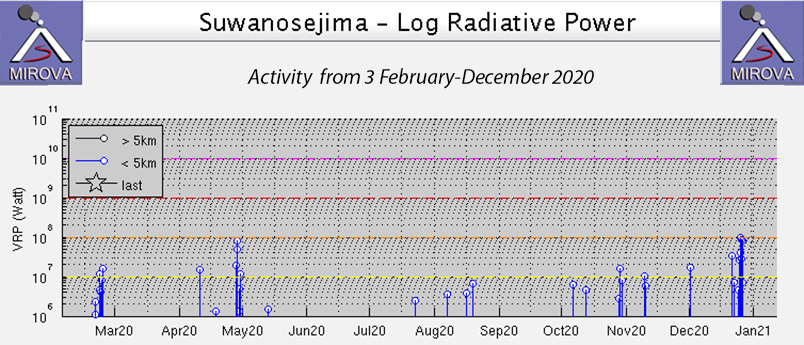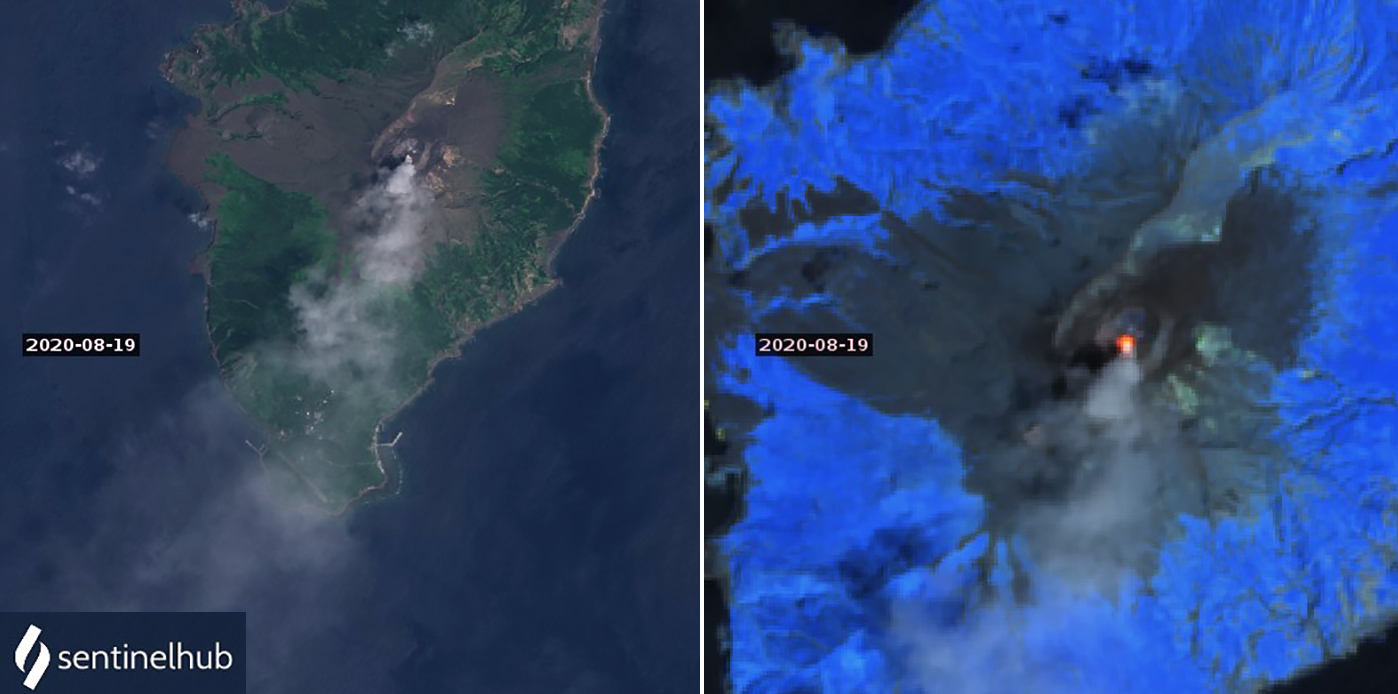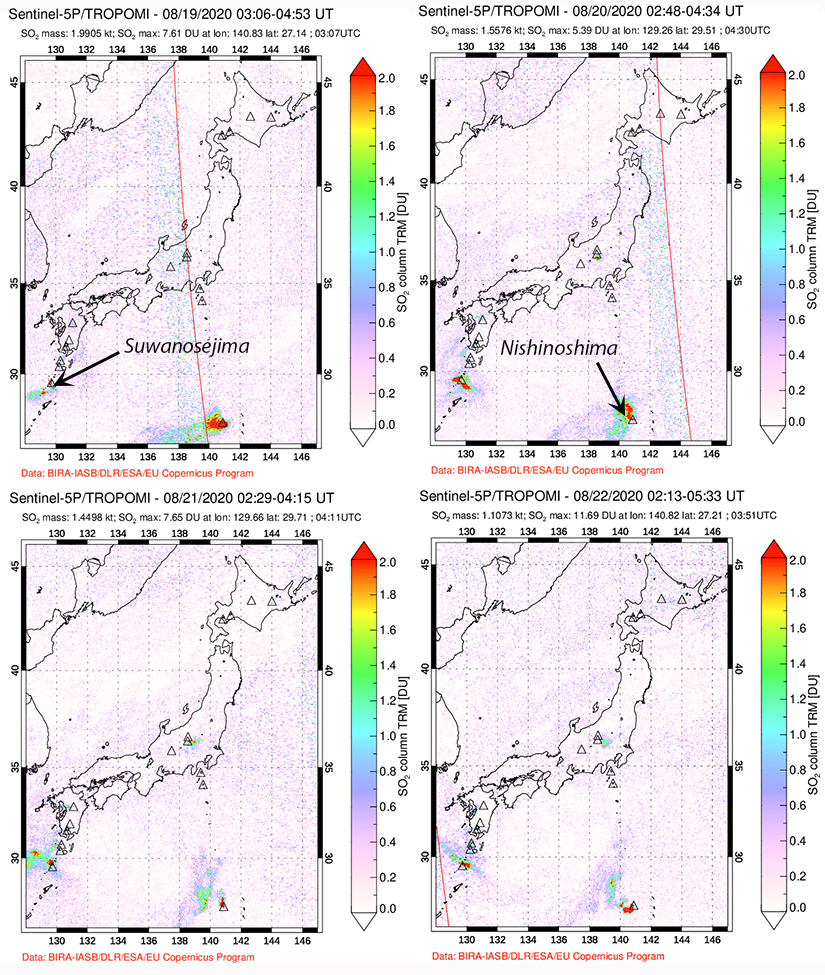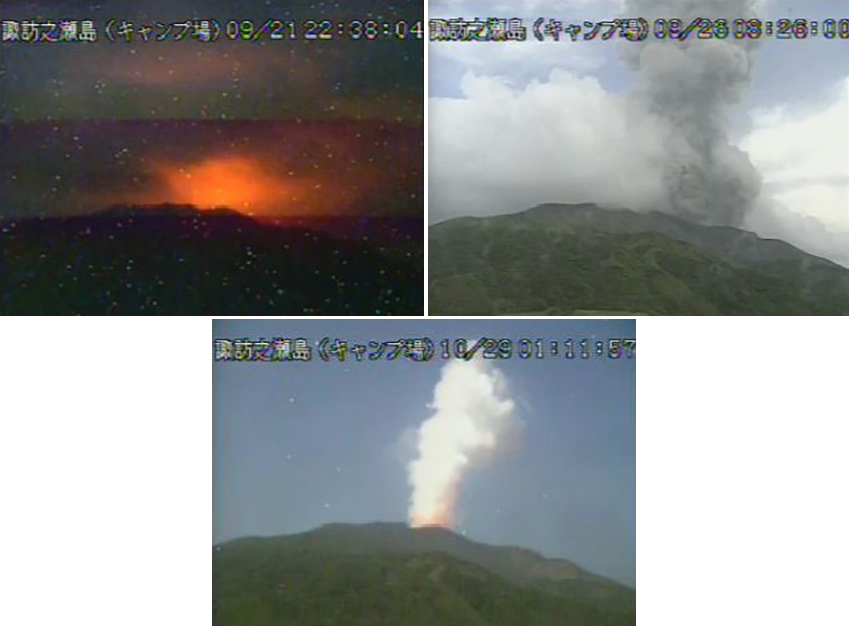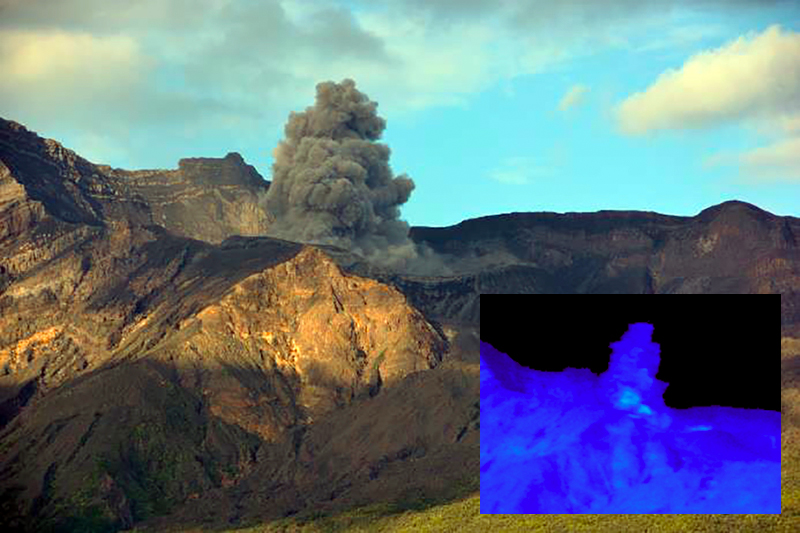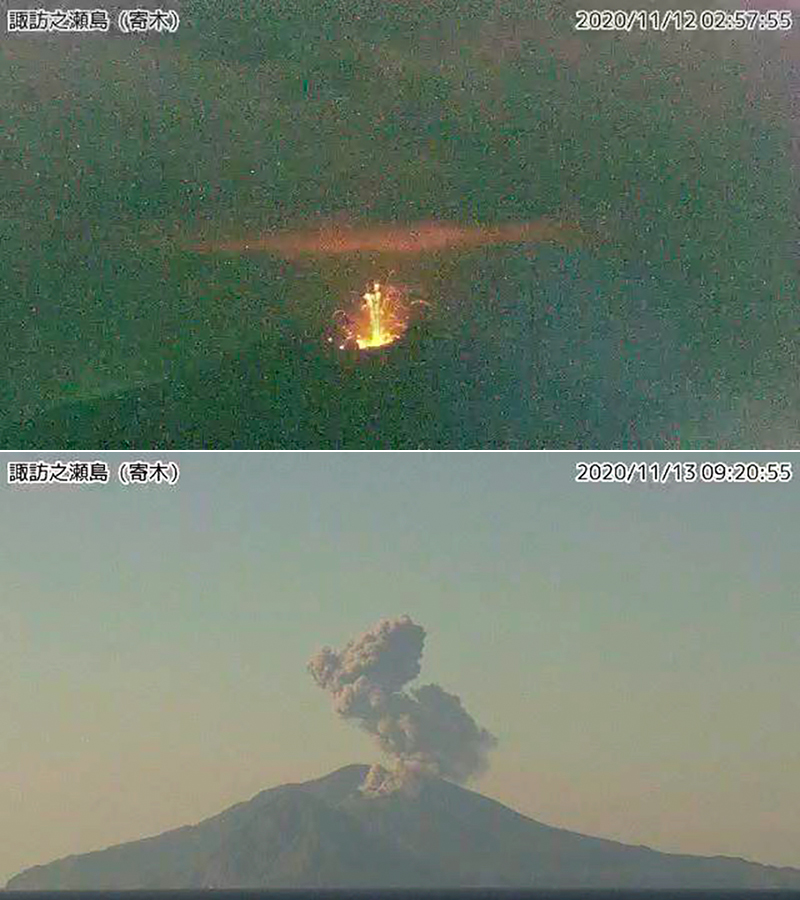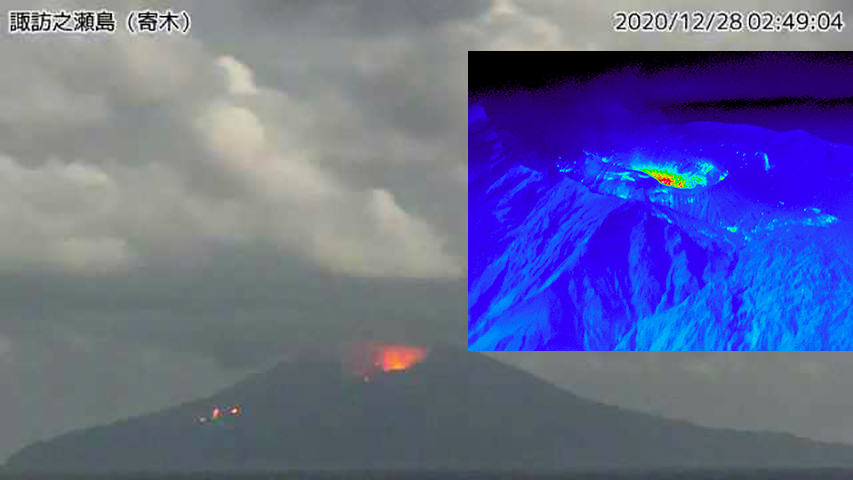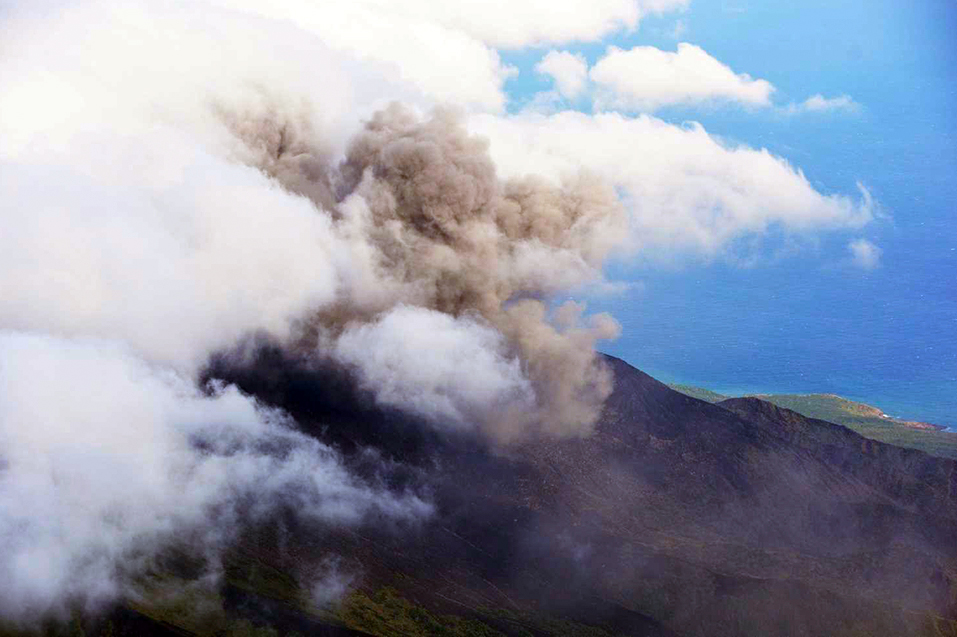Report on Suwanosejima (Japan) — January 2021
Bulletin of the Global Volcanism Network, vol. 46, no. 1 (January 2021)
Managing Editor: Edward Venzke.
Edited by A. Elizabeth Crafford.
Suwanosejima (Japan) Explosion rate increases during July-December 2020, bomb ejected 1.3 km from crater on 28 December
Please cite this report as:
Global Volcanism Program, 2021. Report on Suwanosejima (Japan) (Crafford, A.E., and Venzke, E., eds.). Bulletin of the Global Volcanism Network, 46:1. Smithsonian Institution. https://doi.org/10.5479/si.GVP.BGVN202101-282030
Suwanosejima
Japan
29.638°N, 129.714°E; summit elev. 796 m
All times are local (unless otherwise noted)
Suwanosejima, an andesitic stratovolcano in Japan's northern Ryukyu Islands, was intermittently active for much of the 20th century, producing ash plumes, Strombolian explosions, and ashfall. Continuous activity since October 2004 has included intermittent explosions which generate ash plumes that rise hundreds of meters above the summit to altitudes between 1 and 3 km. Incandescence is often observed at night and ejecta periodically reaches over a kilometer from the summit. Ashfall is usually noted several times each month in the nearby community on the SW flank of the island. Ongoing activity for the second half of 2020, which includes significantly increased activity in December, is covered in this report with information provided by the Japan Meteorological Agency (JMA), the Tokyo Volcanic Ash Advisory Center (VAAC), and several sources of satellite data.
A steady increase in activity was reported during July-December 2020. The number of explosions recorded increased each month from only six during July to 460 during December. The energy of the explosions increased as well; ejecta was reported 600 m from the crater during August, but a large bomb reached 1.3 km from the crater at the end of December. After an increased period of explosions late in December, JMA raised the Alert Level from 2 to 3 on a 5-level scale. The MIROVA graph of thermal activity indicated intermittent anomalies from July through December 2020, with a pulse of activity in the second half of December (figure 48).
Six explosions were recorded during July 2020, compared with only one during June. According to JMA, the tallest plume rose 2,000 m above the crater rim. Incandescent ejecta was occasionally observed at night. The Tokyo VAAC reported a number of ash plumes that rose to 1.2-2.7 km altitude and drifted NW and W during the second half of the month (figure 49). Activity increased during August 2020 when thirteen explosions were reported. The Tokyo VAAC reported a few ash plumes during 1-6 August that rose to 1.8-2.4 km altitude and drifted NW; a larger pulse of activity during 18-22 August produced plumes that rose to altitudes ranging from 1.8 to over 2.7 km. Ashfall was reported on 19 and 20 August in the village located 4 km SSW of the crater; incandescence was visible at the summit and ash plumes drifted SW in satellite imagery on 19 August (figure 50). A MODVOLC thermal alert was issued on 19 August. On 21 August a large bomb was ejected 600 m from the Otake crater in an explosion early in the day; later that afternoon, an ash plume rose to more than 2,000 m above the crater rim. During 19-22 August, SO2 emissions were recorded each day by the TROPOMI instrument on the Sentinel-5P satellite (figure 51).
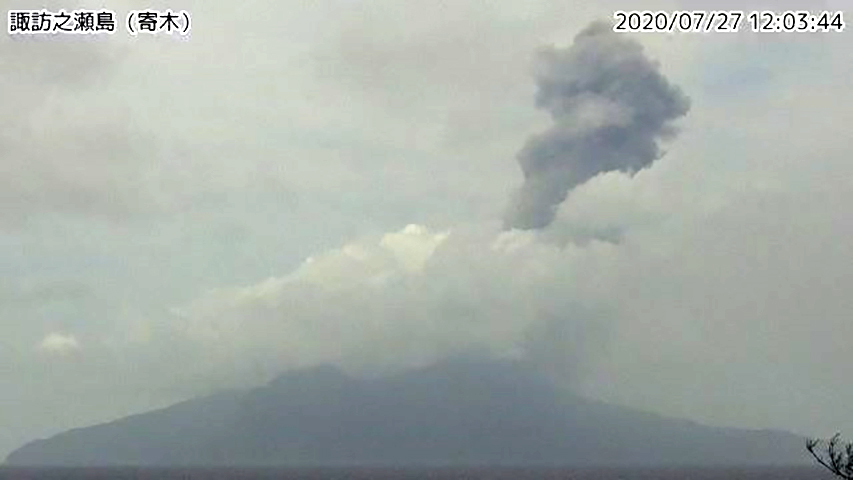 |
Figure 49. An ash emission at Suwanosejima rose to 2.7 km altitude and drifted NW on 27 July 2020. Courtesy of JMA (Volcanic activity commentary material on Suwanosejima, July 2020). |
Thirteen explosions were recorded during September 2020, with the highest ash plumes reaching 2,000 m above the crater rim, and bombs falling 400 m from the crater. Ashfall was recorded on 20 September in the community located 4 km SSW. The Tokyo VAAC reported intermittent ash plumes during the month that rose to 1.2-2.1 km altitude and drifted in several directions. Incandescence was frequently observed at night (figure 52). Explosive activity increased during October with 22 explosions recorded. Ash plumes rose over 2,000 m above the crater rim, and bombs reached 700 m from the crater. Steam plumes rose 2,300 m above the crater rim. Ashfall and loud noises were confirmed several times between 2 and 14 October in the nearby village. A MODVOLC thermal alert was issued on 6 October. The Tokyo VAAC reported multiple ash plumes throughout the month; they usually rose to 1.5-2.1 km altitude and drifted in many directions. The plume on 28 October rose to over 2.7 km altitude and was stationary.
Frequent explosions occurred during November 2020, with a sharp increase in the number of explosions to 105 events compared with October. Ash plumes rose to 1,800 m above the crater rim and bombs were ejected 700 m. Occasional ashfall and loud noises were reported from the nearby community throughout the month. Scientists measured no specific changes to the surface temperature around the volcano during an overflight early on 5 November compared with the previous year. At 0818 on 5 November a small ash explosion at the summit crater was photographed by the crew during an observation flight (figure 53). On 12 and 13 November, incandescent ejecta fell 600 m from the crater and ash emissions rose 1,500 m above the crater rim (figure 54).
During December 2020 there were 460 explosions reported, a significant increase from the previous months. Ash plumes reached 1,800 m above the summit. Three MODVOLC thermal alerts were issued on 25 December and two were issued the next day. The number of explosions increased substantially at the Otake crater between 21 and 29 December, and early on 28 December a large bomb was ejected to 1.3 km SE of the crater (figure 55). A second explosion a few hours later ejected another bomb 1.1 km SE. An overflight later that day confirmed the explosion, and ash emissions were still visible (figure 56), although cloudy weather prevented views of the crater. Ashfall was noted and loud sounds heard in the nearby village. A summary graph of observations throughout 2020 indicated that activity was high from January through May, quieter during June, and then increased again from July through the end of the year (figure 57).
Geological Summary. The 8-km-long island of Suwanosejima in the northern Ryukyu Islands consists of an andesitic stratovolcano with two active summit craters. The summit is truncated by a large breached crater extending to the sea on the E flank that was formed by edifice collapse. One of Japan's most frequently active volcanoes, it was in a state of intermittent Strombolian activity from Otake, the NE summit crater, between 1949 and 1996, after which periods of inactivity lengthened. The largest recorded eruption took place in 1813-14, when thick scoria deposits covered residential areas, and the SW crater produced two lava flows that reached the western coast. At the end of the eruption the summit of Otake collapsed, forming a large debris avalanche and creating an open collapse scarp extending to the eastern coast. The island remained uninhabited for about 70 years after the 1813-1814 eruption. Lava flows reached the eastern coast of the island in 1884. Only about 50 people live on the island.
Information Contacts: Japan Meteorological Agency (JMA), 1-3-4 Otemachi, Chiyoda-ku, Tokyo 100-8122, Japan (URL: http://www.jma.go.jp/jma/indexe.html); MIROVA (Middle InfraRed Observation of Volcanic Activity), a collaborative project between the Universities of Turin and Florence (Italy) supported by the Centre for Volcanic Risk of the Italian Civil Protection Department (URL: http://www.mirovaweb.it/); Hawai'i Institute of Geophysics and Planetology (HIGP) - MODVOLC Thermal Alerts System, School of Ocean and Earth Science and Technology (SOEST), Univ. of Hawai'i, 2525 Correa Road, Honolulu, HI 96822, USA (URL: http://modis.higp.hawaii.edu/); Sentinel Hub Playground (URL: https://www.sentinel-hub.com/explore/sentinel-playground); NASA Global Sulfur Dioxide Monitoring Page, Atmospheric Chemistry and Dynamics Laboratory, NASA Goddard Space Flight Center (NASA/GSFC), 8800 Greenbelt Road, Goddard, Maryland, USA (URL: https://so2.gsfc.nasa.gov/).


